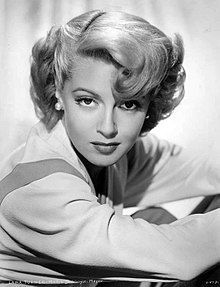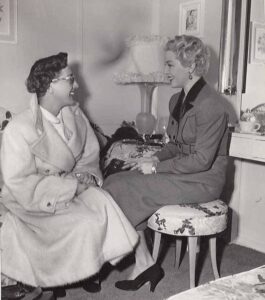A Life of Her Own ** (1950, Lana Turner, Ray Milland) – Classic Movie Review 12,172

‘LANA… as Lily James… a girl who knew what she wanted… and almost got it!’
Director George Cukor’s kitsch and campy 1950 black and white film A Life of Her Own stars Lana Turner and Ray Milland, along with Tom Ewell, Louis Calhern, Ann Dvorak, Barry Sullivan, Jean Hagen, and Phyllis Kirk. Ah, yes, ‘Lana Turner!!, she’s as pretty as a picture, as mean as a tigress’. Ah, no, ‘Lana Turner!!, she was reluctant to make the movie, but was bullied into it by her MGM bosses. This did not turn out specially well for anybody.
MGM’s soapy melodrama stars Lana Turner as Lily James, a small-town beauty from Kansas making good as a model in the big city of New York City only to discover that life isn’t quite as simple as she is. An overblown, vacuous script is saved by George Cukor’s sleek direction, the plush production and Ann Dvorak’s fine turn as Mary Ashlon, a past her sell-by-date catwalker – all hard-boiled cynicism and slow-burning panic.
Also in the cast are Margaret Phillips, Sara Haden, Hermes Pan, Elizabeth Flournoy, Dorothy Tree, Robert Emmett Keane, Richard Anderson, Harry Barris Beverly Garland, Whit Bissell, Kathleen Freeman, Frankie Darro, Queenie Leonard, Paul Kramer, Carol Brewster, Percy Helton, Tom Seidel and Sarah Padden. Whit Bissell and Madge Blake have small roles.
Debut of actress Barbara Darrow and final film of Alice Wallace.
Jean Hagen and Tom Seidel were also married in real life.
A Life of Her Own is directed by George Cukor, runs 108 minutes is made and released by MGM, is written by Isobel Lennart, is shot in black and white by George J Folsey, is produced by Voldemar Vetluguin, is scored by Bronislau Kaper, and is designed by Cedric Gibbons and Arthur Lonergan.
Wendell Corey was cast as Steve Harleigh, but after a disagreement with Lana Turner, he was replaced by Ray Milland after two to three weeks of filming. It was reported in the press that Corey felt he was not right for the role, but it is likely that Turner had him fired. At any rate, it caused the production to go over schedule and over budget, and the film was a box office failure, resulting in a loss of $679,000 for MGM. Turner was reluctant to do the film after a couple of years away from the screen since The Three Musketeers (1948). She refused the role, failing to show for wardrobe fittings, but was forced to do it when studio heads Louis B Mayer and Dore Schary threatened to cancel her contract.
Test audiences’ negative reaction to the original ending in late March 1950 forced retakes in mid-April 1950 for a happier ending, upsetting Cukor.
Bronislau Kaper’s theme music was reused two years later in MGM’s Invitation (1952), and under that title became a jazz standard, associated with tenor saxophonist Joe Henderson.
© Derek Winnert 2022 Classic Movie Review 12,172
Check out more reviews on http://derekwinnert.com


